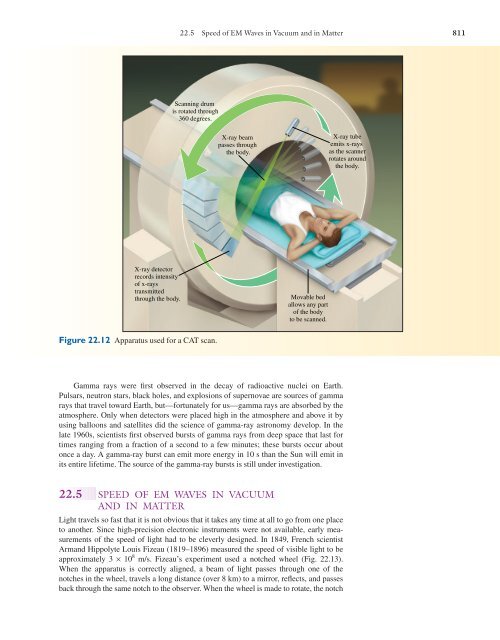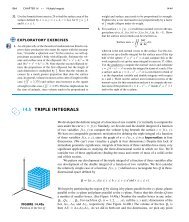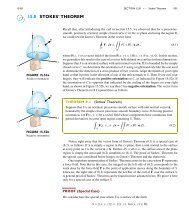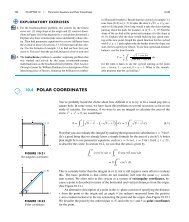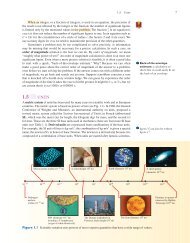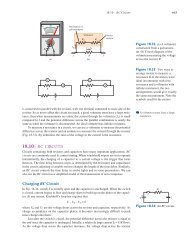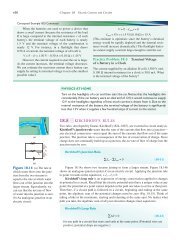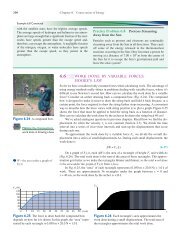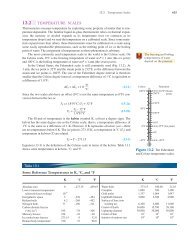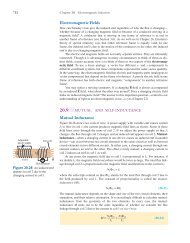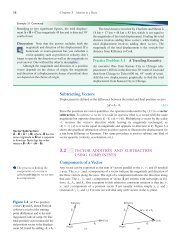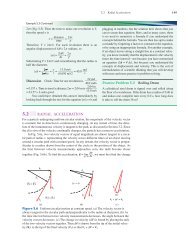SPEED OF EM WAVES IN VACUUM AND IN MATTER
SPEED OF EM WAVES IN VACUUM AND IN MATTER
SPEED OF EM WAVES IN VACUUM AND IN MATTER
You also want an ePaper? Increase the reach of your titles
YUMPU automatically turns print PDFs into web optimized ePapers that Google loves.
22.5 Speed of <strong>EM</strong> Waves in Vacuum and in Matter 811<br />
Scanning drum<br />
is rotated through<br />
360 degrees.<br />
X-ray beam<br />
passes through<br />
the body.<br />
X-ray tube<br />
emits x-rays<br />
as the scanner<br />
rotates around<br />
the body.<br />
X-ray detector<br />
records intensity<br />
of x-rays<br />
transmitted<br />
through the body.<br />
Movable bed<br />
allows any part<br />
of the body<br />
to be scanned.<br />
Figure 22.12 Apparatus used for a CAT scan.<br />
Gamma rays were first observed in the decay of radioactive nuclei on Earth.<br />
Pulsars, neutron stars, black holes, and explosions of supernovae are sources of gamma<br />
rays that travel toward Earth, but—fortunately for us—gamma rays are absorbed by the<br />
atmosphere. Only when detectors were placed high in the atmosphere and above it by<br />
using balloons and satellites did the science of gamma-ray astronomy develop. In the<br />
late 1960s, scientists first observed bursts of gamma rays from deep space that last for<br />
times ranging from a fraction of a second to a few minutes; these bursts occur about<br />
once a day. A gamma-ray burst can emit more energy in 10 s than the Sun will emit in<br />
its entire lifetime. The source of the gamma-ray bursts is still under investigation.<br />
22.5 <strong>SPEED</strong> <strong>OF</strong> <strong>EM</strong> <strong>WAVES</strong> <strong>IN</strong> <strong>VACUUM</strong><br />
<strong>AND</strong> <strong>IN</strong> <strong>MATTER</strong><br />
Light travels so fast that it is not obvious that it takes any time at all to go from one place<br />
to another. Since high-precision electronic instruments were not available, early measurements<br />
of the speed of light had to be cleverly designed. In 1849, French scientist<br />
Armand Hippolyte Louis Fizeau (1819–1896) measured the speed of visible light to be<br />
approximately 3 × 10 8 m/s. Fizeau’s experiment used a notched wheel (Fig. 22.13).<br />
When the apparatus is correctly aligned, a beam of light passes through one of the<br />
notches in the wheel, travels a long distance (over 8 km) to a mirror, reflects, and passes<br />
back through the same notch to the observer. When the wheel is made to rotate, the notch
812 Chapter 22 Electromagnetic Waves<br />
8.6 km<br />
Semitransparent<br />
mirror<br />
Mirror<br />
Figure 22.13 The apparatus<br />
used by Fizeau in 1849 to measure<br />
the speed of light.<br />
Observer<br />
Beam<br />
of light<br />
w<br />
Rotating<br />
notched<br />
wheel<br />
moves out of position and the reflected beam is interrupted by the wheel. As the angular<br />
velocity of the wheel is increased, it reaches a value w where the next notch moves into<br />
position just in time to allow the reflected beam to pass through. The observer can see the<br />
reflected beam for an integral multiple of w, since any of the equally spaced notches<br />
allow the reflected beam to pass through. The speed of light can be determined from a<br />
measurement of the angular velocities at which the observer sees the reflected beam.<br />
In Chapters 11 and 12 we saw that the speed of a mechanical wave depends on<br />
properties of the wave medium. Sound travels faster through steel than it does through<br />
water and faster through water than through air. In every case, the wave speed depended<br />
on two characteristics of the wave medium: one that characterizes the restoring force<br />
and another that characterizes the inertia.<br />
Unlike mechanical waves, electromagnetic waves can travel through vacuum; they<br />
do not require a material medium. Light reaches Earth from galaxies billions of lightyears<br />
away, traveling the vast distances between galaxies without problem; but a sound<br />
wave can’t even travel a few meters between two astronauts on a space walk, since there<br />
is no air or other medium to sustain a sound wave’s pressure variations. What, then,<br />
determines the speed of light in vacuum?<br />
Looking back at the laws that describe electric and magnetic fields, we find two<br />
universal constants. One of them is the permittivity of free space 0 , found in<br />
Coulomb’s law and Gauss’s law; it is associated with the electric field. The second is the<br />
permeability of free space m 0 , found in Ampère’s law; it is associated with the magnetic<br />
field. Since these are the only two quantities that can determine the speed of light in<br />
vacuum, there must be a combination of them that has the dimensions of speed.<br />
The values of these constants in SI units are<br />
0 = 8.85 × 10 –12 2<br />
C<br />
N •m 2<br />
and<br />
m 0 = 4p × 10 –7 T •m <br />
A<br />
The tesla can be written in terms of other SI units. Using F = qv × B as a guide,<br />
N<br />
1 T = 1 <br />
C• m/s<br />
Multiplying 0 × m 0 gives<br />
0 m 0 = 8.85 × 10 –12 2<br />
—C<br />
–N<br />
2 × 4p × 10 –7 –N •–m<br />
<br />
•m<br />
—C•(–m /s)•(—C/s)<br />
= 1.11 × 10 –17 s<br />
<br />
2<br />
m<br />
2<br />
To end up with m/s, we need to take the reciprocal of the square root:<br />
1<br />
= 3.00 × 108 m/s<br />
0 m 0
22.5 Speed of <strong>EM</strong> Waves in Vacuum and in Matter 813<br />
The dimensional analysis done here leaves the possibility of a multiplying factor<br />
such as 1 2 or p. In the mid-nineteenth century, Scottish physicist James Clerk Maxwell<br />
proved mathematically that an electromagnetic wave—a wave consisting of oscillating<br />
electric and magnetic fields propagating through space—could exist in vacuum.<br />
Starting from Maxwell’s equations (Section 22.2), he derived the wave equation, an<br />
equation of a special mathematical form that describes wave propagation for any kind<br />
of wave. In the place of the wave speed appeared ( 0 m 0 ) –1/2 . Using the values of 0 and<br />
m 0 that had been measured in 1856, Maxwell showed that electromagnetic waves in vacuum<br />
travel at 3.00 × 10 8 m/s—very close to what Fizeau measured. Maxwell’s derivation<br />
was the first evidence that light is an electromagnetic wave.<br />
The speed of electromagnetic waves in vacuum is represented by the symbol c (for<br />
the Latin celeritas, “speed”).<br />
Speed of electromagnetic waves in vacuum:<br />
1<br />
c = 0m = 3.00 × 10 8 m/s (22-3)<br />
0<br />
While c is usually called the speed of light, it is the speed of any electromagnetic wave<br />
in vacuum, regardless of frequency or wavelength, not just the speed for frequencies<br />
visible to humans.<br />
Example 22.2<br />
Light Travel Time from a “Nearby” Supernova<br />
A supernova is an exploding star; a supernova is Solution The time for light to travel a distance d at<br />
billions of times brighter than an ordinary star. speed c is<br />
Most supernovae occur in distant galaxies and cannot be<br />
observed with the naked eye. The last two supernovae visible<br />
to the naked eye occurred in 1604 and 1987.<br />
∆t = d 21<br />
c =<br />
1.6<br />
× 10<br />
m<br />
= 5.33 × 10 12 s<br />
3<br />
8<br />
.00<br />
× 10<br />
m/s<br />
Supernova SN1987a (Fig. 22.14) occurred 1.6 × 10 21 To get a better idea how long that is, we convert seconds<br />
m<br />
to years:<br />
from Earth. When did the explosion occur?<br />
5.33 × 10 12 1 yr<br />
s × = 170,000 yr<br />
Strategy The light from the supernova travels at speed c.<br />
3.156 × 10 7 s<br />
The time that it takes light to travel a distance 1.6 × 10 21 m<br />
tells us how long ago the explosion occurred.<br />
Discussion When we look at the stars, the light we<br />
see was radiated by the stars long ago. By looking at distant<br />
galaxies, astronomers get a glimpse of the universe<br />
in the past. Beyond the Sun, the closest star to Earth is<br />
about 4 ly (light-years) away, which means that it takes<br />
light 4 yr to reach us from that star. The most distant<br />
galaxies observed are at a distance of over 10 10 ly; looking<br />
at them, we see over 10 billion yr into the past.<br />
Figure 22.14<br />
Photo of the sky after light from Supernova SN1987a reached<br />
Earth.<br />
Practice Problem 22.2<br />
A Light-Year<br />
A light-year is the distance traveled by light (in vacuum)<br />
in one Earth year. Find the conversion factor from lightyears<br />
to meters.
814 Chapter 22 Electromagnetic Waves<br />
The speed of an <strong>EM</strong> wave<br />
through matter is less than c.<br />
Speed of Light in Matter<br />
When an <strong>EM</strong> wave travels through a material medium, it travels at a speed v that is less<br />
than c. For example, visible light travels through glass at speeds between about<br />
1.6 × 10 8 m/s and 2.0 × 10 8 m/s, depending on the type of glass and the frequency of<br />
the light. Instead of specifying the speed, it is common to specify the index of refraction<br />
n:<br />
Index of refraction:<br />
n = v<br />
c (22-4)<br />
A wave passing from one<br />
medium into another changes<br />
wavelength but retains the<br />
same frequency.<br />
Refraction refers to the bending of a wave as it passes from one medium to another;<br />
we study refraction in detail in Section 23.3. Since the index of refraction is a ratio of two<br />
speeds, it is a dimensionless number. For glass in which light travels at 2.0 × 10 8 m/s, the<br />
index of refraction is<br />
n = 3 8<br />
. 0 × 10<br />
m/<br />
s<br />
= 1.5<br />
8<br />
2.<br />
0 × 10<br />
m/<br />
s<br />
The speed of light in air (at 1 atm) is only slightly less than c; the index of refraction<br />
of air is 1.0003. Most of the time this 0.03% difference is not important, so we can<br />
use c as the speed of light in air. The speed of visible light in an optically transparent<br />
medium is less than c, so the index of refraction is greater than 1.<br />
When an <strong>EM</strong> wave passes from one medium to another, the frequency and wavelength<br />
cannot both remain unchanged since<br />
v = fl<br />
As is the case with mechanical waves, it is the wavelength that changes; the frequency<br />
remains the same. The incoming wave (with frequency f ) causes charges in the atoms at<br />
the boundary to oscillate with the same frequency f, just as for the charges in an<br />
antenna. The oscillating charges at the boundary radiate an <strong>EM</strong> wave at that same frequency<br />
into the second medium. Therefore, the electric and magnetic fields in the second<br />
medium must oscillate at the same frequency as the fields in the first medium. In<br />
just the same way, if a transverse wave of frequency f traveling down a string reaches a<br />
point at which an abrupt change in wave speed occurs, the incident wave makes that<br />
point oscillate up and down at the same frequency f as any other point on the string. The<br />
oscillation of that point sends a wave of the same frequency to the other side of the<br />
string. Since the wave speed has changed but the frequency is the same, the wavelength<br />
has changed as well.<br />
We sometimes need to find the wavelength l of an <strong>EM</strong> wave in a medium of index<br />
n, given its wavelength l 0 in vacuum. Since the frequencies are equal,<br />
c v<br />
f = = l l<br />
Solving for l gives<br />
0<br />
l = v c l 0 = l n 0 (22-5)<br />
Since n > 1, the wavelength is shorter than the wavelength in vacuum. The wave travels<br />
more slowly in the medium than in vacuum; since the wavelength is the distance traveled<br />
by the wave in one period T = 1/f, the wavelength in the medium is shorter.<br />
If blue light of wavelength l 0 = 480 nm enters glass that has an index of refraction<br />
of 1.5, it is still visible light, even though its wavelength in glass is 320 nm; it has not<br />
been transformed into UV radiation. When the light enters the eye, it has the same frequency<br />
and wavelength in the fluid in the eye regardless of how many material media it<br />
has passed through, since the frequency remains the same at each boundary.
22.6 Characteristics of Electromagnetic Waves in Vacuum 815<br />
Example 22.3<br />
Wavelength Change from Glass to Water<br />
The index of refraction of glass is 1.50 and that of water<br />
is 1.33. If light of wavelength 285 nm in glass passes into<br />
water, what is the wavelength in the water?<br />
Strategy The key is to remember that the frequency is<br />
the same as the wave passes from one medium to another.<br />
Solution Frequency, wavelength, and speed are related<br />
by<br />
v = lf<br />
Solving for frequency, f = v/l. Since the frequencies are<br />
equal,<br />
v l w w = v l g<br />
g<br />
<br />
The speed of light in a material is v = c/n. Solving for l w<br />
and substituting v = c/n gives<br />
lg c<br />
l w = v w v<br />
= <br />
g n<br />
× n gl g<br />
w c<br />
= 1.50 × 285nm<br />
= 321 nm<br />
1. 33<br />
Discussion Water has a smaller index of refraction, so<br />
the speed of light in water is greater than in glass. Since<br />
wavelength is the distance traveled in one period, the<br />
wavelength in water is longer (321 nm > 285 nm).<br />
Practice Problem 22.3<br />
from Air to Water<br />
Wavelength Change<br />
The speed of visible light in water is 2.25 × 10 8 m/s.<br />
When light of wavelength 592 nm in air passes into<br />
water, what is its wavelength in water?<br />
Dispersion<br />
Although <strong>EM</strong> waves of every frequency travel through vacuum at the same speed c, the<br />
speed of <strong>EM</strong> waves in a material medium does depend on frequency. Therefore, the<br />
index of refraction is not a constant for a given material; it is a function of frequency.<br />
Variation of the speed of a wave with frequency is called dispersion. Dispersion causes<br />
white light to separate into colors when it passes through a glass prism (Fig. 22.15). The<br />
dispersion of the light into different colors arises because each color travels at a slightly<br />
different speed in the same medium.<br />
A nondispersive medium is one for which the variation in the index of refraction is<br />
negligibly small for the range of frequencies of interest. No medium (apart from vacuum)<br />
is truly nondispersive, but many can be treated as nondispersive for a restricted<br />
range of frequencies. For most optically transparent materials, the index of refraction<br />
increases with increasing frequency; blue light travels more slowly through glass than<br />
does red light. In other parts of the <strong>EM</strong> spectrum, or even for visible light in unusual<br />
materials, n can decrease with increasing frequency instead.<br />
Figure 22.15 A prism separates<br />
a beam of white light (coming<br />
in from the left) into the<br />
colors of the spectrum.<br />
22.6 CHARACTERISTICS <strong>OF</strong> ELECTROMAGNETIC<br />
<strong>WAVES</strong> <strong>IN</strong> <strong>VACUUM</strong><br />
The various characteristics of <strong>EM</strong> waves in vacuum can be derived from the basic laws<br />
of electromagnetism (Maxwell’s equations, Section 22.2). Such a derivation requires<br />
higher level mathematics, so we state the characteristics without proof.<br />
• <strong>EM</strong> waves in vacuum travel at speed c = 3.00 × 10 8 m/s, independent of frequency.<br />
The speed is also independent of amplitude.<br />
• The electric and magnetic fields oscillate at the same frequency. Thus, a single frequency<br />
f and a single wavelength l = c/f pertain to both the electric and magnetic<br />
fields of the wave.<br />
• The electric and magnetic fields oscillate in phase with each other. That is, at a<br />
given instant, the electric and magnetic fields are at their maximum magnitudes at a


